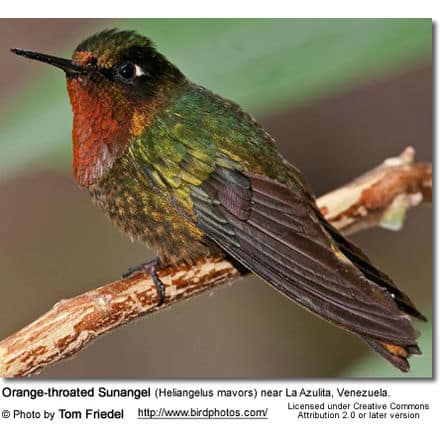Orange-throated Sunangel (Heliangelus mavors)
The Orange-throated Sunangels (Heliangelus mavors) – or Golden-throated Sunangels – are South American hummingbirds that belong to the Sunangel family.

Distribution / Habitat
Orange-throated Sunangels are fairly common within their restricted range that stretches along the eastern slope of the Andes of Colombia, in Norte de Santander to Boyacá; and in northwestern Venezuela from southern Lara to Táchira.
They inhabit tropical moist mountain forests and heavily degraded former forests.
Seasonal elevation movements have been noted – specifically descending to lower elevations during the rainy season.
Description
Orange-throated Sunangels are about 3.7 inches or 9.4 cm long. The straight and short bill measures about 0.6″ or 15 mm in length.
Males:
The plumage above is glossy green. The frontlet above the upper bill and gorget are glittering golden orange (appears black in poor light conditions). Below the throat patch is a broad buff crescent across the chest, followed by a narrow chest band green. The rest of the plumage below is buff. The sides are heavily spotted green. The bronze-green tail has pale tips.
Female:
Similar, but can be identified by her buff-colored throat that is speckled rufous brown. She has a faint buff crescent.
Similar Species:
Amethyst-throated Sunangel, but in good light conditions males can readily be identified by their glittering orange gorgets (throat patches) – as opposed to the purplish-blue gorgets of the Amethyst) and either gender by their buff, rather than white, chest band.
Diet / Feeding
The Orange-throated Sunangels primarily feed on nectar taken from a variety of brightly colored, scented small flowers of trees, herbs, shrubs, and epiphytes. They favor flowers with the highest sugar content (often red-colored and tubular-shaped) and seek out, and aggressively protect, those areas containing flowers with high-energy nectar.
They use their long, extendible, straw-like tongues to retrieve the nectar while hovering with their tails cocked upward as they are licking at the nectar up to 13 times per second. Sometimes they may be seen hanging on the flower while feeding.
Many native and cultivated plants on whose flowers these birds feed heavily rely on them for pollination. The mostly tubular-shaped flowers exclude most bees and butterflies from feeding on them and, subsequently, from pollinating the plants.
They may also visit local hummingbird feeders for some sugar water, or drink out of bird baths or water fountains where they will either hover and sip water as it runs over the edge; or they will perch on the edge and drink – like all the other birds; however, they only remain still for a short moment.
They also take some small spiders and insects – important sources of protein particularly needed during the breeding season to ensure the proper development of their young. Insects are often caught in flight (hawking); snatched off leaves or branches, or taken from spider webs. A nesting female can capture up to 2,000 insects a day.
Males establish feeding territories, where they aggressively chase away other males as well as large insects – such as bumblebees and hawk moths – that want to feed in their territory. They use aerial flights and intimidating displays to defend their territories.
Metabolism and Survival and Flight Adaptions – Amazing Facts
Breeding / Nesting
Hummingbirds are solitary in all aspects of life other than breeding, and the male’s only involvement in the reproductive process is the actual mating with the female. They neither live nor migrate in flocks, and there is no pair bond for this species. Males court females by flying in a U-shaped pattern in front of them. He will separate from the female immediately after copulation. One male may mate with several females. In all likelihood, the female will also mate with several males. The males do not participate in choosing the nest location, building the nest, or raising the chicks.
The female is responsible for building the nest out of plant fibers woven together and green moss on the outside for camouflage in a protected location. She lines the nest with soft plant fibers, animal hair, and feathers down, and strengthens the structure with spider webbing and other sticky material, giving it an elastic quality to allow it to stretch to double its size as the chicks grow and need more room.
The average clutch consists of two to three white eggs, which she incubates alone, while the male defends his territory and the flowers he feeds on. The young are born blind, immobile, and without any down.
The female alone protects and feeds the chicks with regurgitated food (mostly partially digested insects since nectar is an insufficient source of protein for the growing chicks). The female pushes the food down the chicks’ throats with her long bill directly into their stomachs.
As is the case with other hummingbird species, the chicks are brooded only the first week or two and are left alone even on cooler nights after about 12 days – probably due to the small nest size. The chicks leave the nest when they are about 20 days old.
Alternate (Global) Names
Chinese: ????? … Czech: Kolibrík oranžovohrdlý, kolib?ík oranžovohrdlý … Danish: Orangestrubet Solalf … Dutch: Oranjekeelzonnekolibrie, Oranjekeel-zonnekolibrie … Finnish: Oranssienkelikolibri … French: Héliange mars … German: Orangekehlnymphe, Orangekehl-Sonnennymphe … Italian: Angelo del sole gola aranciata, Eliangelo golarancio … Japanese: kieritenshihachidori … Norwegian: Gyllensolengel … Polish: lordzik pomaranczowogardly, lordzik pomara?czowogard?y … Russian: ?????????????? ????? … Slovak: nymfárik hrdzavoprsý … Spanish: Angel del Sol de Cuello Ocre, Ángel Gorginaranja, Colibrí de Marte … Swedish: Gyllensolängel





